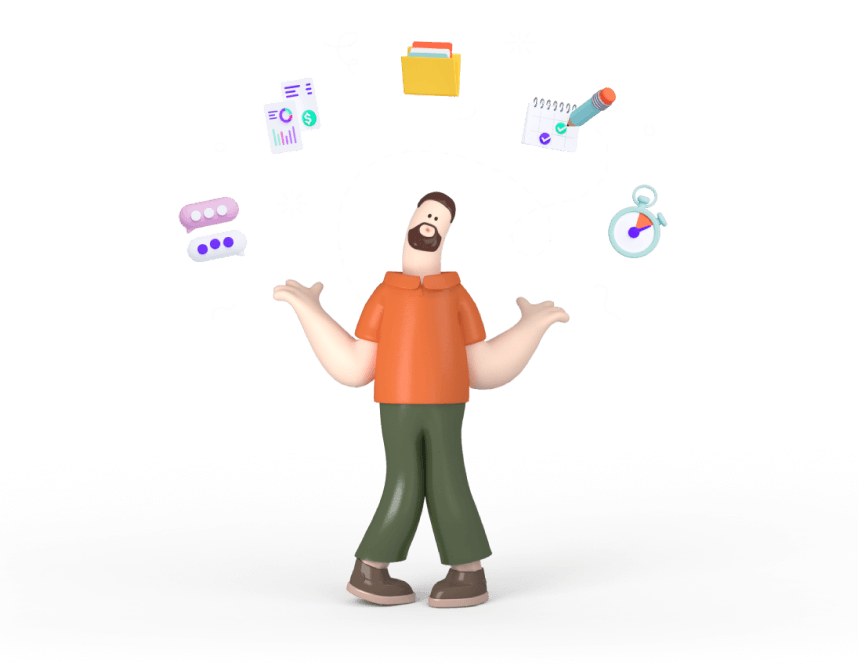Joint Application Development (JAD)
In today's dynamic business world, clear communication between system developers and users is essential. Joint Application Development (JAD) methodology is a popular method that unites these groups to define and refine project requirements collaboratively. This structured and inclusive approach ensures clients actively participate in the development process, resulting in more effective and satisfactory end-products.
What is Joint Application Development (JAD)?

Joint Application Development (JAD) is a widely adopted technique in business analysis, facilitating collaborative environments where system developers and users converge to define and refine project requirements and specifications. This structured approach involves organized discussion groups aimed at achieving consensus and clarity early in the development process.
In a nutshell, the ultimate purpose of JAD is to include the client in the development process and develop a more satisfactory end-product that will meet the client’s needs more efficiently. JAD allows clients to have full autonomy in project development and allows them to participate in their application's development through a series of workshops.
When a business needs some technical input from the technical expertise, a JAD session is required. Likewise, when technical expertise needs business input, JAD is required. This collaborative approach ensures that both business analysts and technical teams are aligned on project objectives and deliverables.
Whenever a business and a technical team are trying to collaborate to make certain decisions about critical issues, there is nothing more effective than organizing a JAD session. By leveraging the strengths of both parties, JAD facilitates a more comprehensive understanding of the project scope and requirements, leading to more efficient and effective solutions.
Evolution of Joint Development Application (JAD)
Joint Development Application (JAD) was pioneered by Chuck Morris of IBM Raleigh and Tony Crawford of IBM Toronto in the late 1970s to boost client satisfaction by bridging the gap between developers and end-users. In the 1980s, they conducted workshops demonstrating its effectiveness, validating its application across industries, especially for small to medium-sized projects. JAD's success underscores its role in enhancing collaboration and efficiency in software development, influencing modern agile practices with an emphasis on inclusive stakeholder engagement.
JAD Participants

When implementing the JAD process, the composition of the JAD team forms the core of project success. Selecting stakeholders with care is crucial as they play a pivotal role in driving the overall success of a JAD session. The key to ensuring an effective JAD session lies in involving critical roles such as Executive Sponsor, Facilitator, Stakeholder, Scribe (Recorder), IT Representative, and Observer.
Executive Sponsor: Typically the manager of the business area from the customer's company who has full authority to make critical decisions concerning the project. Although they do not need to actively participate in every step of the project, they must be available throughout the process to resolve important issues as they arise. Their presence ensures alignment with business objectives and supports major project decisions.
Facilitator: The most crucial role in the JAD process, responsible for planning, executing, and managing the session. This individual should have the right knowledge and extensive experience to lead the project effectively. Working closely with the Executive Sponsor, the Facilitator ensures that desired goals are achieved. During discussions, the Facilitator should:
Focus on the process
Be unbiased and neutral
Lead groups and keep sessions on track
Stop sideline conversations
Stakeholder: The primary focus of the entire process. Without their involvement, JAD sessions would be ineffective. They represent all key user groups affected by the project development and span multiple levels within the organization. The JAD session allows stakeholders to become integral to the project, ensuring the product meets their needs and expectations.
Scribe (Recorder): Responsible for documenting the entire JAD process. Given the volume of ideas and suggestions that can arise, a JAD session may involve multiple Scribes. A Scribe must:
Capture important decisions, who made them, and why.
Distribute and archive documentation at the end of each session.
Have excellent analytical skills to effectively analyze the discussion.
IT Representative: Provides technical advice and helps the JAD team develop logical models to build a prototype. They must:
Help the customer turn their concepts into business requirements
Efficiently utilize available technology
Provide end solutions that are realistic within the budget and timeframe
Observer: Monitors each step of the JAD session, focusing on end-user needs and the overall progress of the session. Their role is to ensure that the session stays aligned with the objectives and that all aspects of the discussion are adequately addressed.
Incorporating these enriched details will provide a comprehensive understanding of the key participants and their roles in a successful JAD session.
JAD Session

JAD session is a collaborative workshop that brings together system developers and users to discuss and define requirements and specifications for a project. This structured approach ensures active participation from all stakeholders, leading to more accurate and efficient development outcomes. Each JAD session must have well-defined objectives and detailed agenda items. You need to ensure you have invited key players from both the business and technical world, as well as the person who will take notes.
You need to ask questions, record important decisions, and assign action items. While the questions and agenda items are the essence of the discussion that will drive the meeting, don't expect to get the answers immediately.
The point of JAD sessions is to trigger creative thinking and brainstorming that will lead to a joint discussion that will require expertise from various departments. Another name for JAD session is requirement workshop because it focuses on gathering and refining project requirements through collaborative efforts. This structured approach ensures that all stakeholders' perspectives are considered, leading to more accurate and efficient development outcomes.
At its core, JAD session should help the teams come up with decisions. If you and your team can't arrive to a decision, you need to run JAD sessions on a scheduled basis, which are usually known as JAD workshops.
The outcome of a JAD session is more valuable than other meetings because you can make more decisions.
Although most of the JAD sessions are scheduled during the development phase, they may even happen during the requirement phase.
JAD Session in Agile
In recent years, Joint Application Development (JAD) has evolved to incorporate agile methodologies, adapting to the dynamic needs of modern software development environments. Agile principles enhance flexibility, responsiveness, and efficiency throughout the development lifecycle. Agile JAD sessions emphasize:
Iterative Approach: Breaking down requirements gathering into smaller, manageable iterations allows for continuous feedback and adjustment.
Collaborative Environment: Close collaboration between cross-functional teams fosters transparency and shared understanding.
Adaptive Planning: Prioritizing adaptive planning over rigid upfront planning enables teams to adjust requirements based on evolving project needs.
Implementing agile principles in JAD sessions improves stakeholder engagement, accelerates time-to-market, and enhances the quality of deliverables. This approach empowers teams to deliver value-driven solutions that meet evolving business requirements effectively.
Joint Application Development (JAD) Phases
For a Joint Application Development (JAD) approach to be successful, it is essential to ensure several key steps are taken:
Clear Objectives and Goals: Define the objectives and goals of the JAD session beforehand. This provides direction and focus during the sessions.
Proper Planning and Preparation: Extensive planning and preparation are crucial. This includes selecting the right participants, setting the agenda, and ensuring all necessary materials and resources are available.
Effective Facilitation: A skilled facilitator is vital for guiding the discussions, keeping the sessions on track, and ensuring that all participants have a chance to contribute.
Active Participation: Ensure active participation from all stakeholders. The success of a JAD session depends on the collaboration and input from both business users and technical teams.
Accurate Documentation: Properly document all discussions, decisions, and requirements. This ensures that nothing is overlooked and provides a reference for future stages of the project.
Follow-Up and Review: After the JAD sessions, follow-up actions and reviews are necessary to ensure that the gathered requirements are correctly implemented and that any issues are addressed promptly.
Key step in order for JAD approach to be successful is proper planning and preparation is ensuring that the right participants are selected, the agenda is set, and all necessary materials are prepared lays the foundation for effective and productive JAD sessions.
JAD Software Tools
Effective Joint Application Development (JAD) sessions rely on specialized software tools that facilitate collaboration, documentation, and communication among stakeholders. These tools streamline the process, ensuring clear requirements and successful project outcomes.
Key Features of JAD Software
Collaborative Workspaces: Platforms like ActiveCollab offer virtual workspaces for real-time collaboration, allowing teams to share ideas and feedback seamlessly.
Visualization Tools: These tools help visualize project workflows and system architectures, aiding in clearer communication and decision-making during JAD sessions.
Session Recording and Documentation: Integrated features in tools like ActiveCollab ensure comprehensive session recording and automated documentation, preserving discussions and decisions for future reference.
Task Management and Scheduling: Built-in task management and scheduling functionalities help coordinate sessions and assign responsibilities, maintaining the momentum of the JAD process.
Requirement Management: JAD software tools, including those integrated with platforms like ActiveCollab, enable precise capture, organization, and prioritization of project requirements.
Advantages of JAD
Simplified Problem Resolution: JAD allows you to resolve difficulties more simply and produce better, error-free software. By involving all key stakeholders early in the process, potential issues can be identified and addressed swiftly.
Reduced Risks: The joint collaboration between the company and the clients lowers all risks. When clients and developers work closely together, misunderstandings are minimized, and the project's risk of failure is significantly reduced.
Cost and Time Efficiency: JAD reduces costs and time needed for project development. With clearly defined requirements from the start, there are fewer chances of costly revisions and delays.
Improved System Quality: Well-defined requirements improve system quality. When all stakeholders contribute to the requirements, the final product is more likely to meet user needs and expectations.
Faster Progress: Due to the close communication, progress is faster. Regular interactions between team members ensure that everyone is on the same page, facilitating quick decision-making and problem-solving.
Enhanced Team Motivation: JAD encourages the team to push each other to work faster and deliver on time. The collaborative environment fosters a sense of shared responsibility and motivation among team members.
Disadvantages of JAD
Alignment Challenges: Different opinions within the team make it difficult to align goals and maintain focus. Diverse perspectives can lead to conflicts, requiring strong facilitation to keep the sessions productive.
Time Commitment: Depending on the size of the project, JAD may require a significant time commitment. Preparing for and conducting JAD sessions can be time-consuming, which might not be feasible for all team members.
High Level of Preparation: As noted in one of the best JAD articles, "JAD sessions require a high level of preparation and commitment from all participants to be effective" (Chatzoglou & Macaulay, 1993). Without adequate preparation, the sessions may not yield the desired outcomes.
JAD vs. RAD
The JAD methodology (Joint Application Development) and RAD (Rapid Application Development) are both pivotal in software development but differ significantly in approach. The JAD methodology emphasizes structured collaboration through workshops with key stakeholders, ensuring comprehensive and consensus-driven project requirements. This leads to well-defined scopes and detailed planning. Conversely, RAD prioritizes speed and flexibility, utilizing rapid prototyping and iterative development. It focuses on quickly delivering functional components and adapting based on continuous user feedback. While JAD excels in stakeholder alignment and meticulous requirement gathering, RAD is advantageous for projects that demand rapid delivery and the ability to accommodate frequent changes.
To conclude, Joint Application Development (JAD) methodology sessions involve experts and stakeholders from various organizations, bringing together their specialized knowledge to collaboratively define and refine information systems architecture. These sessions are crucial in preparing detailed data models and engineering specifications, ensuring that project requirements are precisely defined from the outset. By involving developers early on, JAD methodology facilitates a clear understanding of architectural needs and technical discussions, thereby laying a solid foundation for implementation.
Throughout the JAD process, stakeholders engage in intensive discussions to clarify roles, responsibilities, and project objectives. This collaborative approach not only enhances communication but also fosters a shared understanding among all involved parties. Moreover, by integrating diverse perspectives from experts across different domains, JAD methodology sessions ensure that organizational goals align with technical feasibility, optimizing the development and deployment phases.
Despite these benefits, JAD methodology sessions also present challenges, such as coordinating schedules among busy stakeholders and managing potentially conflicting viewpoints. However, by leveraging structured facilitation techniques and clear definition frameworks, these challenges can be mitigated, allowing teams to focus on achieving consensus and actionable outcomes.
In summary, while JAD methodology sessions require careful planning and facilitation, its ability to harness the expertise of involved stakeholders, define information systems architecture comprehensively, and foster collaborative discussions makes it an indispensable tool for achieving successful project outcomes in today's complex business environment.
Continue reading
Project Management Methodologies Introduction
Get familiar with the most popular methodologies modern project managers use! Learn the basics and choose the best method to manage your teams and projects.
